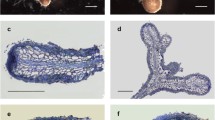Summary
Many plants form yellow coloured roots when colonized by arbuscular mycorrhizal (AM) fungi. In maize, a yellow pigment is first visible as small droplets in parenchyma cells of roots in the vicinity of arbuscules, 3–4 weeks after mycorrhizal colonization. During the course of the development of the plants, the yellow pigment spreads all over the cells of the cortex (with the exception of the exodermis) and of the endodermis, whereas the other stelar elements remain uncoloured. Other gramineous plants (wheat, barley, millet) show the same pattern of pigment formation. In contrast, the deposition of this pigment is not detected in roots ofTagetes, garden bean, onion, or leek. Weak yellow fluorescence is also seen in the fungal structures, particularly in the arbuscules of the investigated probes. This is, however, clearly different from the intense yellow colour of the pigment formed in root cells of grasses. The yellow pigment is even detected in such cells which are never colonized by fungal structures (e.g., endodermal cells). A major constituent of the yellow pigment of AM-colonized root cells has been identified as a carotenoid with 14 carbon atoms and two carboxylic groups and termed mycorradicin. This carotenoid is likely deposited in the vacuoles of root cells as a result of the colonization specifically by arbuscular fungi.
Similar content being viewed by others
References
Ames RN, Ingham ER, Reid CPP (1982) Ultraviolet induced autofluorescence of arbuscular mycorrhizal root infections: an alternative to clearing and staining methods for assessing infections. Can J Microbiol 28: 351–355
Becker NN, Gerdemann JW (1977) Colorimetric quantification of vesicular-arbuscular mycorrhizal infection in onion. New Phytol 78: 289–295
Bonfante-Fasolo P (1988) The role of the cell wall as a signal in mycorrhizal associations. In: Scannerini S, Smith DC, Bonfante-Fasolo P, Gianinazzi-Pearson V (eds) Cell to cell signals in plant, animal and mycorrhizal symbiosis. Springer, Berlin Heidelberg New York Toyko, pp 219–235 (NATO ASI series, series H, vol 17)
Daft M, Nicolson THC (1969) Effect ofEndogone mycorrhiza on plant growth. III. Influence of inoculum concentration on growth and infection in tomato. New Phytol 68: 953–963
Dehne HW, Backhaus DF (1986) The use of vesicular-arbuscular mycorrhizal fungi in plant production. I. Inoculum production. Z Pflanzenkrankh Pflanzenschutz 93: 415–424
Erdtman H (1948) Corticrocin, a pigment from the mycelium of a mycorrhiza fungus. Acta Chim Scand 2: 209–219
Eschenmoser W, Eugster CH (1975) 188. Absolute Konfiguration von Azafrin. Helv Chim Acta 58: 1722–1727
Fyson A, Oaks A (1992) Rapid methods for quantifying VAM fungal infections in maize roots. Plant Soil 147: 317–319
Harley JH, Smith SE (1983) Mycorrhizal symbiosis. Academic Press, London
Jabaji-Hare SH, Perumalla CJ, Kendrick WB (1984) Autofluorescence of vesicles, arbuscules and intercellular hyphae of a vesicular-arbuscular fungus in leek (Allium porrum) roots. Can J Bot 62: 2665–2669
Jones FR (1924) A mycorrhizal fungus in the roots of legumes and some other plants. J Agric Res 29: 459–470
Klingner A, Bothe H, Wray V, Marner FJ (1994) Identification of a yellow pigment formed in maize roots upon mycorrhizal colonization. Phytochemistry (in press)
Schmitz O, Danneberg G, Hundeshagen B, Klingner A, Bothe H (1991) Quantification of vesicular-arbuscular mycorrhiza by biochemical parameters. J Plant Physiol 139: 106–114
Toth R, Miller RM (1984) Dynamics of arbuscular development and degeneration in aZea mays mycorrhiza. Amer J Bot 71: 449–460
Zechmeister L (1934) Carotinoide. Springer, Berlin
Author information
Authors and Affiliations
Rights and permissions
About this article
Cite this article
Klingner, A., Hundeshagen, B., Kernebeck, H. et al. Localization of the yellow pigment formed in roots of gramineous plants colonized by arbuscular fungi. Protoplasma 185, 50–57 (1995). https://doi.org/10.1007/BF01272753
Received:
Accepted:
Issue Date:
DOI: https://doi.org/10.1007/BF01272753



